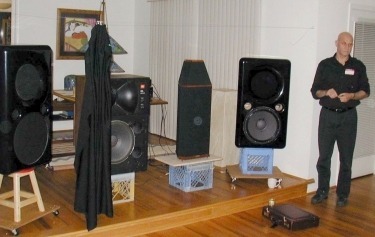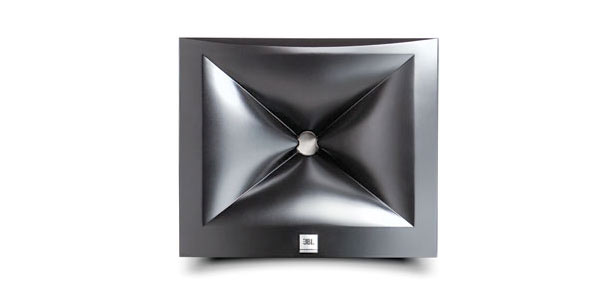About a year ago I figured out how to model JBL's Image Control Waveguide.
I also want a horn that's cross fired, like the JBL Everest DD5000.
Last but not least, I think that adding some oblate spheroidal goodness is smart.
So this horn will have the following features:
1) the funky 'knuckles' of the JBL M2's Image Control Waveguide
2) the built in crossfire of the JBL Everest DD5000 horn
3) Some OS goodness for diffraction reduction
The reason I want the 'knuckles' is because I think I can use those to hide the midrange taps for a Synergy Horn

Here's a pic of the curves required for the horn. The 'trick' is that it's basically two horns stitched together at the center. One horn has a very large radius; the other side does not.

When it's done it will look something like this.
I also want a horn that's cross fired, like the JBL Everest DD5000.
Last but not least, I think that adding some oblate spheroidal goodness is smart.
So this horn will have the following features:
1) the funky 'knuckles' of the JBL M2's Image Control Waveguide
2) the built in crossfire of the JBL Everest DD5000 horn
3) Some OS goodness for diffraction reduction
The reason I want the 'knuckles' is because I think I can use those to hide the midrange taps for a Synergy Horn

Here's a pic of the curves required for the horn. The 'trick' is that it's basically two horns stitched together at the center. One horn has a very large radius; the other side does not.

When it's done it will look something like this.
The Making of a Monitor: An Inside Look at How JBL Developed the M2 and Re-ignited Its Studio Line | Mixonline
Here's some info on the Image Control Waveguide:
"The key to integrating the driver and woofer, then, was the third key innovation: the patent-pending Image Control Waveguide, developed by Senior Systems Engineer Charles Sprinkle, working side-by side with Harman Corporate Technology Group’s Alan Devantier, responsible for system tuning and design of the enclosure, including the patented front ports.
“The Bi-Radial horn that we have had for decades was a 90x60 horn, and not the best match for the low frequency device in the M2,” Sprinkle says. “This horn is 120 degrees horizontal and 110 degrees vertical. We knew that if we wanted a good directivity transition between the woofer and the high frequencies, we had to have that amount of pattern, so the waveguide was designed to have a pattern consistent with what the woofer was doing with no discontinuity at the crossover point, which is 800 Hz.
“The second thing we did was use a blending geometry—there are no straight lines, you’ll notice—that has a generally decreasing radius,” he continues, “forming an infinite number of reflections, and the net effect is that it smears the reflections coming back down the horn and negates them.
“The third thing we did is bring these ‘knuckles,’ which is a name that sort of stuck, in from the side so that rather than having this 1.5-inch aperture that we had in the Bi-Radial design, we were able to get the upper pattern control frequency up near 10k, much like it would be with a 25mm dome. You combine that with a high-frequency device that has the internal damping characteristics this driver has, and it sounds like a silk-dome! That nice, sweet, effortless, open sound. In the process, that directivity characteristic in the mid-band went away. Alan was really a champion of doing the right thing with the architecture: driver placement, making the cabinet taller—that opened the door to the work that was done on the waveguide.”
From Chaikin’s point of view, the new waveguide delivers remarkable high-frequency detail, a true soundstage with natural balance at nearly any listening position, and a neutral frequency response both on- and off-axis, allowing for optimum performance in a broad range of environments, large and small, whether soffit-mounted, free-standing or behind a screen. A product for the professional in everyone.
Translating what he said into English:


The current JBL waveguides have a common ancestor, which is the biradial horns from the 80s. Pictured above is Earl Geddes' JBLs, which had that biradial horn. As time has progressed, you'll notice that the diffraction slot in the JBL horns has slowly disappeared for the most part. Diffraction slots sound gross, which is why the listeners at that audio meeting preferred the sound of the Gedlee Summa to the JBL with the biradial horn.

But diffraction slots solve a waveguide problem. What if you want wide vertical coverage, but you also want low frequency loading? The diffraction slot solves that challenge. The additional 2" of depth in the diffraction slot loads the driver, while also having very wide directivty from the wide angle of the waveguide that the diffraction slot is feeding into. So the M2 diffraction slot has those funky 'knuckles' which allow a fraction of the radiation into the diffraction slot, but not 100%
Here's some info on the Image Control Waveguide:
"The key to integrating the driver and woofer, then, was the third key innovation: the patent-pending Image Control Waveguide, developed by Senior Systems Engineer Charles Sprinkle, working side-by side with Harman Corporate Technology Group’s Alan Devantier, responsible for system tuning and design of the enclosure, including the patented front ports.
“The Bi-Radial horn that we have had for decades was a 90x60 horn, and not the best match for the low frequency device in the M2,” Sprinkle says. “This horn is 120 degrees horizontal and 110 degrees vertical. We knew that if we wanted a good directivity transition between the woofer and the high frequencies, we had to have that amount of pattern, so the waveguide was designed to have a pattern consistent with what the woofer was doing with no discontinuity at the crossover point, which is 800 Hz.
“The second thing we did was use a blending geometry—there are no straight lines, you’ll notice—that has a generally decreasing radius,” he continues, “forming an infinite number of reflections, and the net effect is that it smears the reflections coming back down the horn and negates them.
“The third thing we did is bring these ‘knuckles,’ which is a name that sort of stuck, in from the side so that rather than having this 1.5-inch aperture that we had in the Bi-Radial design, we were able to get the upper pattern control frequency up near 10k, much like it would be with a 25mm dome. You combine that with a high-frequency device that has the internal damping characteristics this driver has, and it sounds like a silk-dome! That nice, sweet, effortless, open sound. In the process, that directivity characteristic in the mid-band went away. Alan was really a champion of doing the right thing with the architecture: driver placement, making the cabinet taller—that opened the door to the work that was done on the waveguide.”
From Chaikin’s point of view, the new waveguide delivers remarkable high-frequency detail, a true soundstage with natural balance at nearly any listening position, and a neutral frequency response both on- and off-axis, allowing for optimum performance in a broad range of environments, large and small, whether soffit-mounted, free-standing or behind a screen. A product for the professional in everyone.
Translating what he said into English:


The current JBL waveguides have a common ancestor, which is the biradial horns from the 80s. Pictured above is Earl Geddes' JBLs, which had that biradial horn. As time has progressed, you'll notice that the diffraction slot in the JBL horns has slowly disappeared for the most part. Diffraction slots sound gross, which is why the listeners at that audio meeting preferred the sound of the Gedlee Summa to the JBL with the biradial horn.

But diffraction slots solve a waveguide problem. What if you want wide vertical coverage, but you also want low frequency loading? The diffraction slot solves that challenge. The additional 2" of depth in the diffraction slot loads the driver, while also having very wide directivty from the wide angle of the waveguide that the diffraction slot is feeding into. So the M2 diffraction slot has those funky 'knuckles' which allow a fraction of the radiation into the diffraction slot, but not 100%
Last edited:

The trick with the Image Control Waveguide is that there's a horn nested inside of a horn. One horn has a diffraction slot. The other horn doesn't.
It's a real p.i.t.a. to render, particular if you're listening off-axis like I am.


A conventional diffraction slot has a sharp edge that creates diffraction at the transition from the slot to the rest of the horn

I'm using a gentle radius to reduce diffraction

Here we have two horns, identical in size, one with a diffraction slot, one without

The two horns are nested together, and there's an "X" that's pressed into the orthogonals. The "X" shape allows sound in the diffraction slot to radiate into the rest of the waveguide, but not 100% of the sound. This creates numerous pathlengths, I think this is partially responsible for the ridiculously smooth response of the JBL M2. If you think about it, all horns are resonant. The Image Control Waveguide behaves like a spectrum of horns, about the same size, with slightly different pathlenghts. The quote from the designer in post #2 seems to confirm this.

With the two horns nested together, and the "X" pressed into the one with the diffraction slot, we get this

Here's the real deal for comparison. Mine isn't exactly the same, by design; I made the transition from the diffraction slot to the rest of the horn smoother.
- Status
- This old topic is closed. If you want to reopen this topic, contact a moderator using the "Report Post" button.
- Home
- Loudspeakers
- Multi-Way
- Oblate Spheroid + Image Control Waveguide + Everest DD5000


